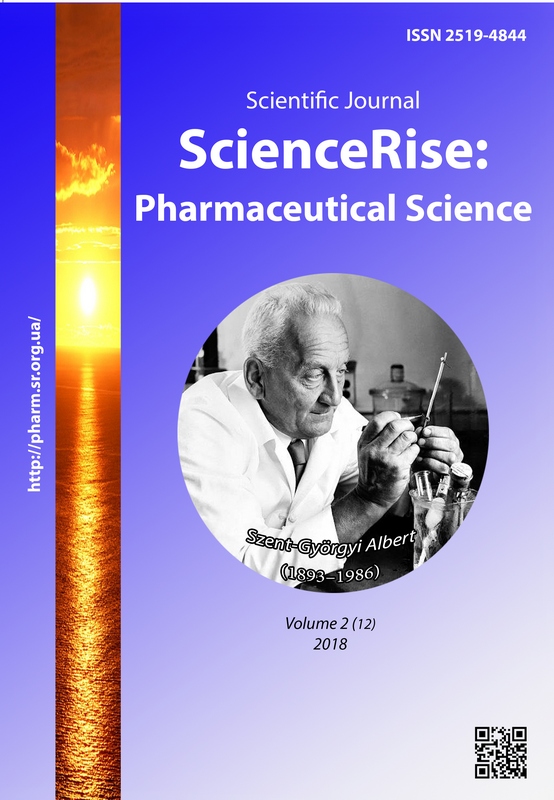Scaling of the prospective anti-ulcer API synthesis
DOI:
https://doi.org/10.15587/2519-4852.2018.128885Keywords:
active pharmaceutical ingredient, industrial synthesis, scaling, green chemistry, 1, 2, 4 triazole derivatives, antiulcer agentsAbstract
Aim: the scaling of the laboratory procedure for the synthesis of 5-(4-methylphenylaminomethyl-4-(2-methylphenyl)-1,2,4-triazole-4H-3-ylthioacetic acid 4-methoxyanilide (Triazoprazole) for reproduction in industrial conditions.
Methods. In the development of industrial technology, the efficiency of synthesis (yields at each stage of synthesis, the possibility of carrying out synthesis without isolation of some intermediates), compliance with the principles of green chemistry, and economic feasibility were evaluated. In accordance with the concept of Quality by design, the principles of green chemistry and previously developed algorithms for optimizing industrial synthesis, the theoretical possibilities of synthesis in industrial conditions were analyzed. The optimal reaction conditions are determined experimentally.
Results. As a result of the experimental studies, the possibility of the synthesis of the key intermediate, 5-methylphenylaminomethyl-4- (2-methylphenyl) -1,2,4-triazole-3-thione, without isolation of the intermediate product, has been shown to increase its yield in terms of starting materials . The time for carrying out individual stages of synthesis has been shortened, and the yield and purity of the products remain appropriate. For the alkylation of the key intermediate, the reaction temperature is chosen as the optimum conditions-70 °C, the time is 1 hour, the use of the DMF-alkali system. Such conditions make it possible to ensure a high yield and purity of the final product.
Conclusions: Scaling of the method of synthesis of a potential API with the antiulcer action of 5- (4-methylphenylaminomethyl-4- (2-methylphenyl) -1,2,4-triazole-4H-3-ylthioacetic acid 4-methoxyanilide for use in industrial production using Quality by design concept and "green chemistry"principles was carrying out, The number of stages of synthesis has been reduced and the conditions have been chosen in which the finished product is formed with the maximum yield and acceptable purity
References
- Taschuk, V. K., Solobiukova, N. A., Makarov, A. A. (2017). Effectiveness of Thiotriazolin in a Complex Treatment of the Patients with Acute Coronary Syndrome without ST Elevation. Emergency medicine, 8 (79), 35–43. doi:10.22141/2224-0586.8.79.2016.90371
- Solobiukova, N. A., Makarov, A. A., Svishhenko, E. P. (2015). Metaanaliz effektivnosti i bezopasnosti primeneniya lekarstvennogo sredstva Tiotriazolin® pri stabil'nykh formakh ishemicheskoy bolezni serdtsa. Arterial'naya gipertenziya, 6 (44), 31–37.
- Loyd, V. A. (Ed.) (2013). Remington, the science and practice of pharmacy. London-Philadephia: The pharmaceutical Press, 3056.
- Georgiyants, V., Perekhoda, L., Saidov, N., Kadamov, I. (2014). Synthesis, docking studies, and biological evaluation of anti-ulcer activity of 4-allyl-5-(4-R1)-phеnylthiomethyl-1,2,4-trіаzоle-3-ylmercaptoаcetic acid derivatives. European Chemical Bulletin, 3 (5), 466–471.
- Perekhoda, L., Kadamov, I., Saidov, N., Georgiyants, V. (2015). Synthesis of novel substituted 4-phenyl-5-phenoxymethyl-3-mercapto-1,2,4-triazole (4 H) derivatives as potential anti-ulcer agents. Scripta Scientifica Pharmaceutica, 2 (2), 46–52. doi: 10.14748/ssp.v2i2.1300
- Kavraiskiy, D. P., Shtrygol, S. Yu., Georgiyants, V. A., Saidov, N. B. (2016). Screening investigation of novel 1,2,4-triazole-3-thione derivatives on anticonvulsant activity. American Journal of pharmacology and phytotherapy, 1 (1), 10–14.
- Kushniruk, V. M., Severina, A. I., Georgiyants, V. A. (2017). Standardization of the Active Pharmaceutical Ingredients Industrial Synthesis Technology. Acta Chimica and Pharmaceutica Indica, 7 (2). Available at: http://www.tsijournals.com/abstract/standardization-of-the-active-pharmaceutical-ingredients-industrial-synthesis-technology-13367.html
- Boraei, A. T. A., Gomaa, M. S., El Ashry, E. S. H., Duerkop, A. (2017). Design, selective alkylation and X-ray crystal structure determination of dihydro-indolyl-1,2,4-triazole-3-thione and its 3-benzylsulfanyl analogue as potent anticancer agents. European Journal of Medicinal Chemistry, 125, 360–371. doi: 10.1016/j.ejmech.2016.09.046
- Ghattas, A. E.-B. A. G., Moustafa, H. M., Hassanein, E. A. A., Hussein, B. R. M. (2016). Synthesis and antibacterial activity of some new 4-anilino-5-phenyl-4H-1,2,4-triazole-3-thiol derivatives. Arabian Journal of Chemistry, 9, 1654–1659. doi: 10.1016/j.arabjc.2012.04.016
- Li, C., Liu, J.-C., Li, Y.-R., Gou, C., Zhang, M.-L., Liu, H.-Y. et. al. (2015). Synthesis and antimicrobial evaluation of 5-aryl-1,2,4-triazole-3-thione derivatives containing a rhodanine moiety. Bioorganic & Medicinal Chemistry Letters, 25 (15), 3052–3056. doi: 10.1016/j.bmcl.2015.04.081
- Georgiyants, V. A., Kushniruk, V. N., Bevz, N. Yu., Bezuglyi, P. A. (2013). Kontseptsiya Quality by design v proizvodstve aktivnikh farmatsevticheskikh ingredientov. 1. Analiz faktorov, vliyayushhikh na kachestvo pri planirovanii proizvodstva (sinteza) substantsii amizona. Vestnik Tadzhikskogo natsional'nogo universiteta. Seriya estestvennykh nauk, 1/3 (110), 81–84.
- Anastas, P. T., Warner, J. C. (1998). Green Chemistry: Theory and Practice, Oxford University Press: New York, 30.
- Saha, A., Kumar, R., Kumar, R., Devakumar, C. (2010). Development and assessment of green synthesis of hydrazides. Indian Journal of Chemistry Section B, 49B, 526–531
- European Comission. No 1272/2008. The classification, labelling and packaging of chemical substances and mixtures. Available at: http://ec.europa.eu/environment/chemicals/labelling/history_en.htm
Downloads
Published
How to Cite
Issue
Section
License
Copyright (c) 2018 Narzullo Saidov

This work is licensed under a Creative Commons Attribution 4.0 International License.
Our journal abides by the Creative Commons CC BY copyright rights and permissions for open access journals.








